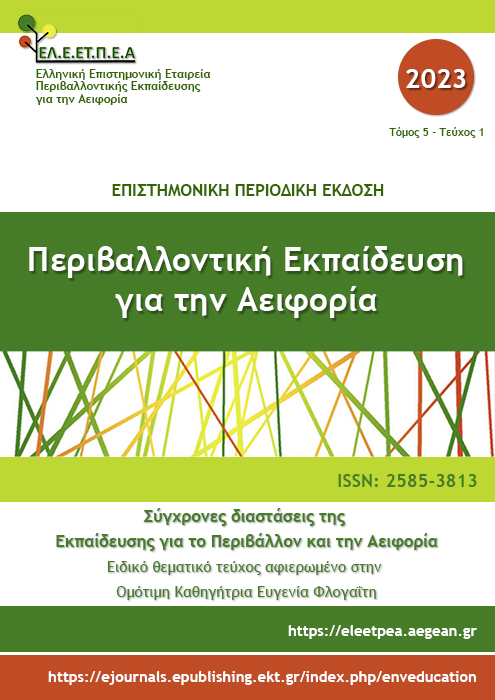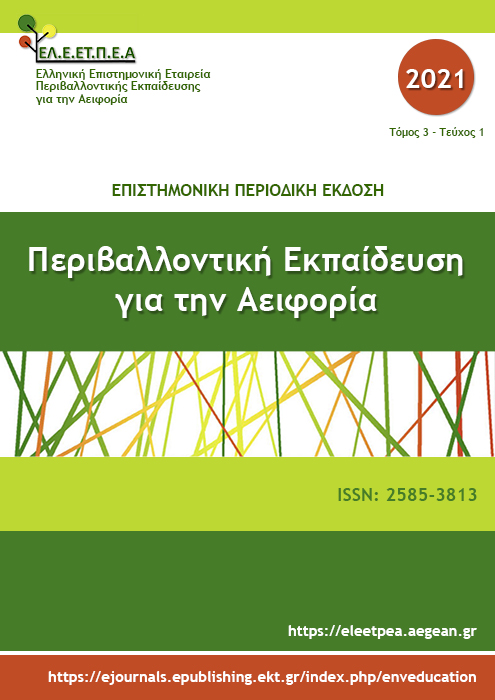Δημιουργικότητα και εκπαίδευση για το περιβάλλον και την αειφορία: μια γόνιμη και εξελισσόμενη σχέση
Abstract
Τα τελευταία χρόνια η παγκόσμια κοινότητα έχει έρθει αντιμέτωπη με κρίσιμα ζητήματα που απειλούν την ευημερία της. Ο άνθρωπος καλείται να ανταπεξέλθει στις σύγχρονες προκλήσεις, επιστρατεύοντας τις γνώσεις και τις δεξιότητες που απαιτούνται ώστε να βρεθούν βιώσιμες λύσεις σε σύνθετα, δυσεπίλυτα προβλήματα, όπως είναι και τα περιβαλλοντικά. Σε αυτή τη δύσκολη εξίσωση, η δημιουργικότητα αναδεικνύεται ως καίριας σημασίας ικανότητα που μπορεί να ξεκλειδώσει το ανθρώπινο δυναμικό και να συμβάλλει στην ανάδυση νέων και πρωτοποριακών προτάσεων δράσης για μια ισορροπημένη διαβίωση του ανθρώπου στον πλανήτη. Στο παρόν άρθρο η δημιουργικότητα αναδεικνύεται ως σημαντική ποιότητα που επιτρέπει στον άνθρωπο να ανταποκρίνεται στις αυξανόμενες απαιτήσεις ενός ταχέως μεταβαλλόμενου κόσμου. Παράλληλα, υπογραμμίζεται η προστιθέμενη αξία της δημιουργικής σκέψης ως ικανότητα-κλειδί για την αντιμετώπιση των σύνθετων ζητημάτων περιβάλλοντος και αειφορίας. Αρχικά, παρατίθεται η βιβλιογραφική ανασκόπηση των βασικών θεωρητικών διαστάσεων της δημιουργικότητας. Στη συνέχεια, στοιχειοθετείται η εξέχουσα σημασία της ικανότητας για την εκπαίδευση, με αφετηρία τις απόψεις πρωτοπόρων θεωρητικών της μάθησης ως τις μέρες μας, όπου η δημιουργικότητα συγκαταλέγεται ανάμεσα στις βασικές δεξιότητες μάθησης για τον 21ο αιώνα. Στη συνέχεια, προσεγγίζεται η γόνιμη και αλληλεπιδραστική σχέση ανάμεσα στη δημιουργικότητα και την αειφορία, η οποία επιτρέπει στον άνθρωπο να οραματίζεται και να διαπραγματεύεται νέες ιδέες για την επίτευξη ενός βιώσιμου μέλλοντος. Το άρθρο ολοκληρώνεται με την παρουσίαση των βασικών διαστάσεων της έρευνας σε διεθνές και τοπικό επίπεδο για την εξέταση της δημιουργικότητας στο εκπαιδευτικό πλαίσιο, εστιάζοντας στην εκπαίδευση για το περιβάλλον και την αειφορία.
Article Details
- Come citare
-
Καλαφάτη Μ. (2023). Δημιουργικότητα και εκπαίδευση για το περιβάλλον και την αειφορία: μια γόνιμη και εξελισσόμενη σχέση. Περιβαλλοντική Εκπαίδευση για την Αειφορία, 5(1), 80–94. https://doi.org/10.12681/ees.35764
- Sezione
- Articles

Questo lavoro è fornito con la licenza Creative Commons Attribuzione - Non commerciale - Condividi allo stesso modo 4.0 Internazionale.
Οι συγγραφείς διατηρούν τα πνευματικά δικαιώματα και παρέχουν στο περιοδικό το δικαίωμα της πρώτης δημοσίευσης μαζί με την αδειοδότηση της εργασίας με CC-BY-NC-SA, που επιτρέπει σε άλλους να μοιράζονται αυτή την εργασία με αναγνώριση του συγγραφικού δικαιώματος και την αρχική δημοσίευση σε αυτό το περιοδικό.



